Name Nimbarka Nimbarka Role Philosopher | Guru Narada | |
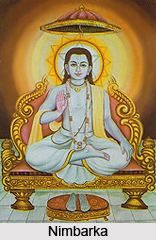 | ||
Titles/honours Nimbabhaskar, Nimbaditya , Sudarshanchakravatar Literary works Vedanta Parijata Saurabh, Gita Bhashya, Dashsloki Schools of thought Nimbarka Sampradaya, Vaishnavism | ||
Philosophical era Medieval philosophy | ||
Shri krishna bhajan i hey nimbarka din bandhu
Nimbarka is known for propagating the Vaishnava Theology of Dvaitadvaita (dvaita-advaita) or “dualistic non-dualism". It is also known as 'Bhedābheda' (bheda-abheda) philosophy.
Contents
- Shri krishna bhajan i hey nimbarka din bandhu
- Radhashtami nimbarka sampradaya samaj gaayan radhe radhe radhike
- Philosophy
- Five Sadhanas
- Karma ritual action
- Vidya
- Upasana or dhyana meditation
- Prapatti Surrender to the LordDevotion
- Gurupasatti
- The disciplic tradition today
- References

According to his eponymous tradition, the Nimbārka Sampradāya, Śrī Nimbārkāchārya appeared in the year 3096 BCE, when the grandson of Arjuna was on the throne. Contrarily, scholars headed by Prof. Roma Bose theorise he lived in the 13th Century, on the presupposition that Śrī Nimbārkāchārya was the author of the work Madhvamukhamardana. This has been proven to be an erroneous attribution.

Bhandarkar has placed him after Ramanuja, suggesting 1162 AD as the date of his demise. S.N.Dasgupta dated Nimbarka to around middle of 14th Century. On the other hand, S. A. A. Rizvi assigns a date of c.1130–1200 AD.

Current scholarship has pointed out that in Bhandarkar's own work it is clearly stated that this was an approximation based on an extremely flimsy calculation, yet most scholars chose to honour his suggested date, even until modern times. The latest scholarship has demonstrated with a high degree of clarity that Nimbarka and his immediate disciple Shrinivasa flourished well before Ramanuja, and that Shrinivasa was a contemporary, or just after Sankaracarya.
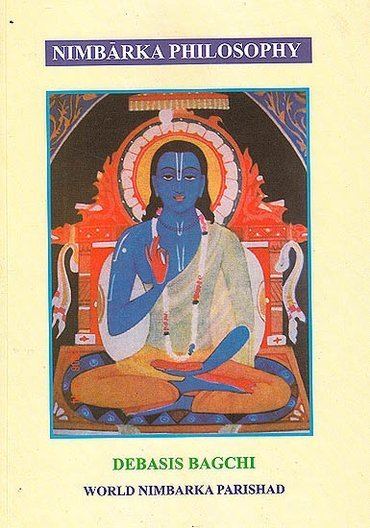
According to tradition, Nimbārka was born in Vaidūryapattanam, the present-day Mungi Village, Paithan in East Maharashtra. His parents were Aruṇa Ṛṣi and Jayantī Devī. Together, they migrated to Mathurā and settled at what is now known as Nimbagrāma (Neemgaon), situated between Barsānā and Govardhan.
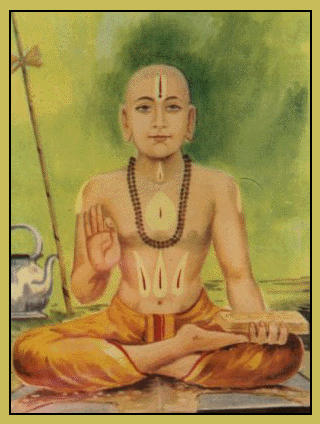
Radhashtami nimbarka sampradaya samaj gaayan radhe radhe radhike
Philosophy
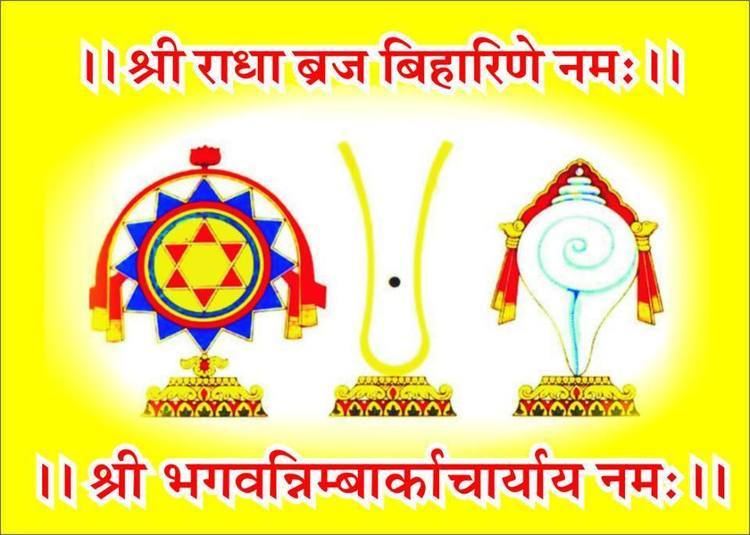
Nimbarka's philosophical position is known as Dvaitadvaita (duality and nonduality at the same time or dualistic non-dualism). The categories of existence, according to him, are three, i.e., cit, acit, and Isvara. Cit and acit are different from Isvara, in the sense that they have attributes and capacities, which are different from those of Isvara. Isvara is independent and exists by Himself, while cit and acit have existence dependent upon Him. At the same time cit and acit are not different from Isvara, because they cannot exist independently of Him. Difference means a kind of existence which is separate but dependent, (para-tantra-satta-bhava) while non-difference means impossibility of independent existence (svatantra-satta-bhava).

Thus Nimbarka equally emphasises both difference and non-difference, as against Ramanuja, who makes difference subordinate to non-difference, in as much as, for him cit and acit do not exist separately from Brahman, but its body or attributes. Thus, according to Nimbarka, the relation between Brahman, on the one hand, and the souls (cit) and universe (acit) on the other, is a relation of natural difference-non-difference (svabhavika-bhedabheda), just like between snake and coil, or between sun and its rays. Just as the coil is nothing but the snake, yet different from it, just as the different kinds of stones, though nothing but earth, are yet different from it, so the souls and the universe, though nothing but Brahman (brahmatmaka), are different from Him because of their own peculiar natures and attributes.
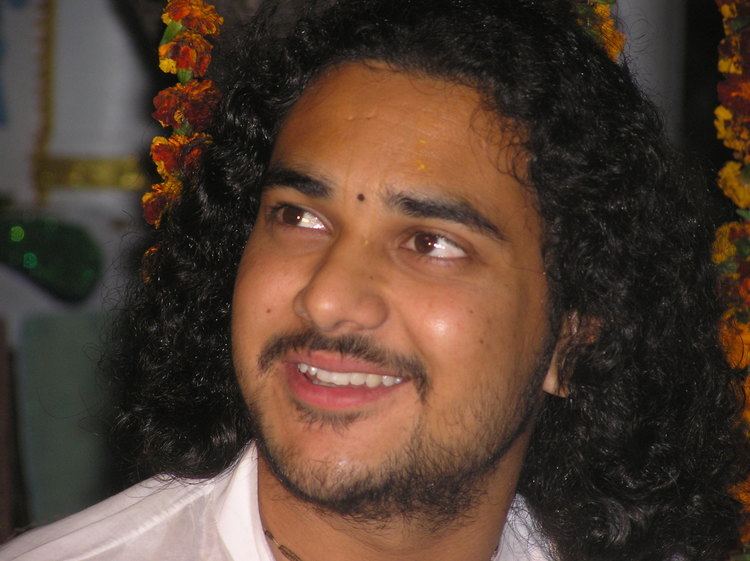
Thus, according to Nimbarka, there are three equally real and co-eternal realities, viz. Brahman, the cit and the acit. Brahman is the Controller (niyantr), the cit the enjoyer (bhoktr) and the acit the object enjoyed (bhogya).
Nimbarka accepts parinamavada to explain the cause of animate and inanimate world, which he says exist in a subtle form in the various capacities (saktis) which belong to Brahman in its natural condition. Brahman is the material cause of the universe in the sense that Brahman brings the subtle rudiments into the gross form by manifesting these capacities.
For Nimbarka the highest object of worship is Krishna and His consort Radha, attended by thousands of gopi's, or cowherdesses, of the celestial Vrindavan. Devotion according to Nimbarka, consists in prapatti, or self-surrender.
Five Sadhanas
Sri Nimbarka refers to 5 methods to Salvation:
Karma (ritual action)
Performed conscientiously in a proper spirit, with one’s varna (caste) and asrama (phase of life) thereby giving rise to knowledge which is a means to salvation).
Vidya
Not as a subordinate factor of karma but also not as an independent means for everyone; only for those inclined to spending vast lengths of time in scriptural study and reflection on deeper meanings.
Upasana or dhyana (meditation)
It is of three types. First is meditation on the Lord as one's self, i.e. meditation on the Lord as the Inner Controller of the sentient. Second is meditation on the Lord as the Inner Controller of the non-sentient. Final one is meditation on Lord Himself, as different from the sentient and non-sentient. This is again not an independent means to Salvation for all, as only those qualified to perform the upasana (with Yajnopavitam) can perform this Sadhana.
Prapatti (Surrender to the Lord/Devotion)
Devotion and self-surrender to God as Shri Radha Krsna. This method of attaining Salvation, known as Prapatti Sadhana, contains elements of all the other means, and is most importantly, available to all. Men, women, foreigners, all classes and castes (or non-castes) are permitted to seek liberation through this, the most important Sadhana. It is referred to as Sadhana (or Apara) Bhakti – devotion through regulations. This in turn leads to Para Bhakti – the highest devotion characterised by Madhurya Rasa – the sweet emotions of devotion experienced by those perfected in Sadhana Bhakti.
Gurupasatti
Devotion and self-surrender to guru. Best realised as a part in Prapatti, and not as an independent means, although it can be so.
Sri Nimbarka made the "Bhasya" (commentary in which alle the words of the verses are used, in contradistinction to a tika, which is a more free commentary) of the Brahmasutra on his Dvaitadvaita Vedanta (Principle of Dualism-Nondualism) in his famous book "Vedanta Parijata Sourabha".
The disciplic tradition today
Upon reaching the leader Svāmī Harivyāsa Devacārya (c.1470-1540 CE), the 35th leader, the tradition was reformed. He anointed twelve of his senior disciples to lead missions throughout the land. The most famous are Svāmī Paraśurāma Devācārya (c.1525-1610 CE) and Svāmī Svabhūrāma Devācārya (fl. 16th century).
Svāmī Paraśurāma Devācārya was anointed as the leader of the entire movement. He was given the śālagrāma deity known as Śrī Sarveśvara that was handed down through time it is believed from Nimbārka himself. The 48th and current leader of the entire Nimbārka Sampradāya is H.D.H. Jagadguru Nimbārkācārya Svāmī Śrī Rādhāsarveśvara Śaraṇa Devācārya, known in reverence as Śrī Śrījī Māhārāja by his followers. He is based in Nimbārka Tīrtha Rajasthan, India. He is the current leader of the Sampradāya, who worships the śālagrāma deity known as Śrī Sarveśvara. His followers are mainly in Rajasthan and Vṛndāvana, Mathura. He established the Mandir at the birth site of Śrī Nimbārkācārya in Mungi Village, Paithan, Maharashtra in 2005. In addition, he oversees the maintenance of thousands of temples, hundreds of monasteries, schools, hospitals, orphanages, cow-shelters, environmental projects, memorial shrines, etc., and arranges various scholarly conventions, religious conferences, medical camps & outreach, etc.
Svāmī Svabhūrāma Devācārya (fl.16th century CE) was born in Budhiya Village, outside Jagadhri and Yamunanagar near Kurukshetra in modern Haryana, India. He established over 52 temples in Punjab, Haryana and Vraja during his lifetime; his current followers are found mostly in Vṛndāvana, Haryana, Punjab, Bengal, Rajasthan, Orissa, Assam, Sikkim, Bihar, other regions in Uttar Pradesh and Maharashtra, also in significant numbers in Nepal.
In his sub-lineage, there are many branches. Notable saints of this sub-branch include the famous Saint Swami Chatur Chintamani Nagaji Maharaj, who started the Vraja Parikrama. This tradition has been continuously maintained over 528 years by the Acharyas of the Svabhurāma-Dwara (sub-lineage). In this same tradition Swami Sri Ramdas Kathiababa came to Vrindavan and made his first monastery there. This branch is currently led by Swami Ras Bihari Das Kathia Baba at Sri Kathia Baba Ka Sthan, Sridham Vrindavan, India. This ashram is known as the Gurugadi, or seat of the Guru, of this sub-branch as a continuation of the lineage of Swami Ram Das Kathia Baba, Swami Santadas Kathiababa and Swami Dhananjaya Das Kathia Babaji Maharaj. Swami Dhananjaya Das Kathia Babaji built several ashrams. The present Acharya Swami Ras Bihari Dasji Kathia Baba has constructed 20 new temples and monasteries in India and abroad. Another Acharya of this lineage is Swami Brindaban Bihari Das Mahanta Maharaj at Kathia Baba ka Ashram, Shivala, Varanasi, Uttar Pradesh and Sukhchar, 24-Parganas (North), West Bengal, who has undertaken projects for orphans and aged persons, building schools and elderly care homes. He travels relentlessly to spread Nimbarka Philosophy through world religion conferences held in US, UK, Sweden, Africa, Bangladesh and other different countries across the globe. The Sukhchar Kathiababar Ashram was originally established by Swami Dhananjaydas Kathiababa and is presently headed by Swami Brindabanbiharidas Mahanta Maharaj.
The famous teacher and leader Svāmī Haripriyā Śaraṇa Devācārya, founded the temple and monastery at Bihari Ji Ka Bageecha, Vṛndāvana, sponsored by his disciple, the philanthropic Shri Hargulal Beriwala and the Beriwala Trust in the 19th century. The predecessor of the current successor was Svāmī Lalitā Śaraṇa Devācārya, who died in July 2005 at the age of 103. One of his other disciples is the world-renowned Svāmī Gopāla Śaraṇa Devācārya, who has founded the Monastery and temple known as the Shri Golok Dham Ashram in New Delhi and Vṛndāvana. He has also helped ordinary Hindus who are not Vaiṣṇava to establish temples overseas. Of note are the Glasgow Hindu Mandir, Scotland, UK: the Lakshmi Narayan Hindu Mandir, Bradford, UK; and the Valley Hindu Temple, Northridge, CA. He has also facilitated major festivals at the Hindu Sabha Mandir in Brampton, Canada.
Another of the famous leaders was Sri Radhavallabh Sharan Devacharya who presided at the Baijiraj Temple in Udaipur, Rajasthan. He is succeeded by Mahant Sri Mohansharan Ji. In Abu Road, Swami Shri Yugal Sharan Ji Brahmachari takes care of Shri Pat Narayan Dham, a wondrous centre worshipping an ancient deity of Lord Visnu. He provides top level Ayurvedic care and has thousands of patients visiting daily.
The Mithila Kunj Ashram is operated by disciples in the tradition of Swami Shri Mukund Devacharya (fl.16th century), another of Swami Shri Harivyas Devacharya's 12 main disciples. At Vamshi Vata, the site of austerities of Harivyasa's preceptor, Swami Shri Shribhatta, the branch of Swami Shri Uddhava Ghamanda Devacharyaji has its headquarters. Swami Uddhava Ghamanda Devacharya ji, another of the 12 disciples of Swami Shri Harivyasa Devacharya is of note for his establishment of the practise of Rasa Lila performances, which continue today and are performed by devotees initiated in other sects and even folk artists. His disciples are led by Swami Roop Kishor Devacharya based at Shri Chain Bihari Ji Kunj.
